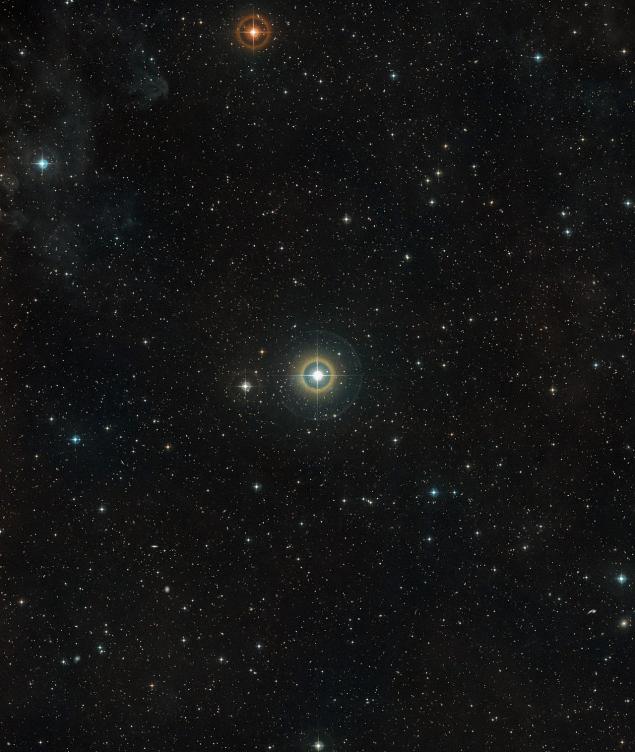531
For the first time captured the light of the exoplanet in the visible spectrum
Ninety eight million one hundred sixty six thousand nine hundred fifty three
Astronomers discover exoplanets, or planets around other stars, almost 20 years — though not quite direct way. These discoveries were purely scientific, and therefore a milestone, which we write in this article should cause almost goose bumps. The first time we have seen an exoplanet directly in 2008. Now we have the first official discovery of exoplanets in the visible light spectrum, made by hunter HARPS planets and 3.6-metre telescope at the ESO Observatory La Silla in Chile.
This exoplanet orbits the star 51 Pegasi is about 50 light years from Earth in the constellation Pegasus. Remarkably, this exoplanet 51 Pegasi b the first exoplanet discovered in 1995 orbiting a normal star like our Sun. For Amateur astronomers: 51 Pegasi has a value of 5.49, which means you can just see it without binoculars or telescope, if you go out under the clear night sky. Fortunately, we have much more sophisticated equipment to strain your eyes peering into the not-so-distant stars.

A wide field of light, captured by ESO
Although there are a number of methods to search for exoplanets around stars, most commonly for the analysis of the atmosphere of the exoplanet transmission spectroscopy is used. Using this method, astronomers measure the spectrum of a star, which is filtered by planet's atmosphere during the passage. When a star passes in front of the planet, you can obtain information about the temperature of the exoplanet. However, this method is quite complicated, because extrasolar planets are extremely dim compared to the parent star and often completely lost in the rays of the latter.
"This detection method is of great scientific importance, as it allows to measure the real mass and the inclination of the orbit of the planet, and it is important for a full understanding of the system, said Jorge Martins, the head of the team of scientists that received the. — It also allows us to measure the reflectivity of the planet, or the albedo, which can be used to determine the composition of the planet's surface and its atmosphere." 51 Pegasi is estimated that by the age of 7-8 all the billions of years, a couple billion years older than our Sun. Although the exoplanet 51 Pegasi b is considered a hot Jupiter, and is unlikely to shelter life, the idea that it could be a civilization older than our own, underwhelming. Scientists continue to conduct monitoring, armed with advanced telescopes: Very Large telescope and European Extremely Large telescope, which will soon be launched.
Last week NASA announced that brings together experts from different scientific fields in a new coalition to search for alien life on planets outside our Solar system.published
P. S. And remember, only by changing their consumption — together we change the world! ©
Source: hi-news.ru
Astronomers discover exoplanets, or planets around other stars, almost 20 years — though not quite direct way. These discoveries were purely scientific, and therefore a milestone, which we write in this article should cause almost goose bumps. The first time we have seen an exoplanet directly in 2008. Now we have the first official discovery of exoplanets in the visible light spectrum, made by hunter HARPS planets and 3.6-metre telescope at the ESO Observatory La Silla in Chile.
This exoplanet orbits the star 51 Pegasi is about 50 light years from Earth in the constellation Pegasus. Remarkably, this exoplanet 51 Pegasi b the first exoplanet discovered in 1995 orbiting a normal star like our Sun. For Amateur astronomers: 51 Pegasi has a value of 5.49, which means you can just see it without binoculars or telescope, if you go out under the clear night sky. Fortunately, we have much more sophisticated equipment to strain your eyes peering into the not-so-distant stars.

A wide field of light, captured by ESO
Although there are a number of methods to search for exoplanets around stars, most commonly for the analysis of the atmosphere of the exoplanet transmission spectroscopy is used. Using this method, astronomers measure the spectrum of a star, which is filtered by planet's atmosphere during the passage. When a star passes in front of the planet, you can obtain information about the temperature of the exoplanet. However, this method is quite complicated, because extrasolar planets are extremely dim compared to the parent star and often completely lost in the rays of the latter.
"This detection method is of great scientific importance, as it allows to measure the real mass and the inclination of the orbit of the planet, and it is important for a full understanding of the system, said Jorge Martins, the head of the team of scientists that received the. — It also allows us to measure the reflectivity of the planet, or the albedo, which can be used to determine the composition of the planet's surface and its atmosphere." 51 Pegasi is estimated that by the age of 7-8 all the billions of years, a couple billion years older than our Sun. Although the exoplanet 51 Pegasi b is considered a hot Jupiter, and is unlikely to shelter life, the idea that it could be a civilization older than our own, underwhelming. Scientists continue to conduct monitoring, armed with advanced telescopes: Very Large telescope and European Extremely Large telescope, which will soon be launched.
Last week NASA announced that brings together experts from different scientific fields in a new coalition to search for alien life on planets outside our Solar system.published
P. S. And remember, only by changing their consumption — together we change the world! ©
Source: hi-news.ru























